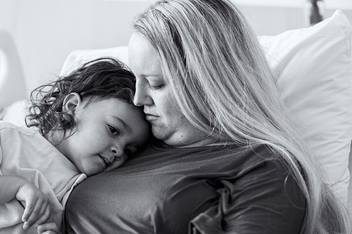Colostomy
A colostomy is a surgical procedure performed on children who are unable to pass feces safely due to disease or anatomical defect. Colostomies are generally recommended for:
- Babies who are born without an anal opening.
- Babies who have a fistula (an abnormal opening) that is allowing waste to spill into the bladder.
For the colostomy, the surgeon will create a stoma (surgical hole) in the abdomen, and attach the upper part of the colon to the stoma. Stool goes through the stoma and into a collection bag that is attached outside of the body. The colostomy allows your baby to excrete waste safely, have normal digestion and growth, and reduces the risk of infection while they wait for the next surgery.
The colostomy is also helpful to have in place after your child’s reconstructive surgery, to give the surgery site a chance to heal.
The colostomy is an essential part of your child’s reconstructive surgery process. Parents play an important role in ensuring that the colostomy is well-maintained both before and after colostomy closure. Good care can have a huge impact on your child’s future bowel health and control.
The following topics provide an overview of the colostomy process, and how to care for your child.
Colostomy Surgery: What to Expect
In children with anorectal malformations, colostomies are performed within the first few days of birth.
Your child will be sedated for the surgery, and will need to stay in the hospital for a few days to recover from the procedure. While in the hospital, your child will receive IV fluids and antibiotics to help prevent infection, and pain medication, if needed. Your child’s ostomy will need daily special care. A nurse will teach you how to care for your child’s ostomy before you leave the hospital.
Click here to access Nationwide Children's Helping Hand on ostomy care.
For more information regarding stoma care please visit the United Ostomy Association of America website.
Colostomy Closure: What to Expect
The colostomy is usually closed about two to three months after the main repair. For the procedure, the surgeon will close the hole in the abdomen and reconnect the two sections of the colon. After the colostomy is closed, your child won’t be able to eat for about 24 to 48 hours. This allows the new connection between the two parts of the colon to heal. Babies usually start passing stool through the new rectum within two to three days, and most children can go home shortly after they begin passing stool.
Your medical team will give you detailed instructions for how to manage your child’s recovery, including the prevention of diaper rash and constipation. Constipation management is extremely important to ensuring your child’s future success with potty training and bowel control.
Colostomy Closure: Looking Ahead
Post-surgery recovery plans are designed to help your child heal and set the stage for successful, long term bowel control. These plans can cover several aspects of your child’s health including diet, anal dilations, wound care, and potty training.
Here are key topic areas for parents caring for a child who has had colostomy closure surgery:
- Managing diaper rash
- Preventing constipation: The constipation challenge
- Post-closure nutrition
- A parent’s checklist for colostomy closure recovery
While surgeries can help repair the parts of the body needed to pass solid waste, in cannot always restore the nerves and sphincter muscles the body relies on to tell a child when it’s time to go to the bathroom. In cases where there are missing or damaged nerves, or sphincter muscles, severe constipation or difficulties with potty training, a bowel management program may be needed.
All of this may feel overwhelming at times, but the medical staff at Nationwide Children’s Center for Colorectal and Pelvic Reconstruction (CCPR) are there to answer your questions and help you each step of the way at CCPR@nationwidechildrens.org.



